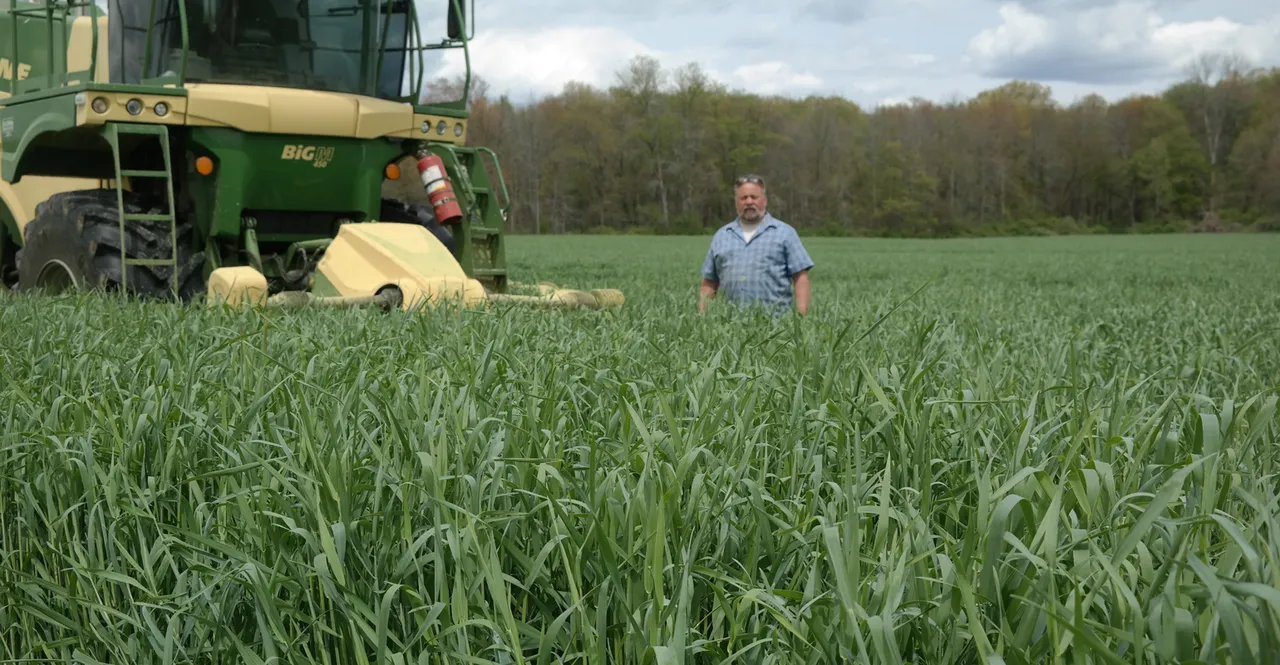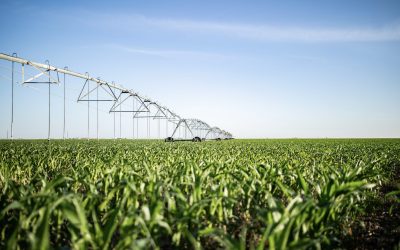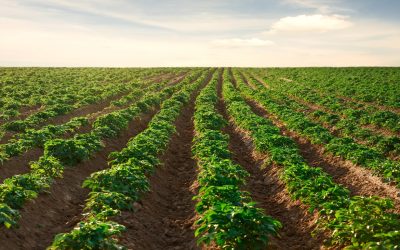Key Takeaways
- Triticale requires 45% less water than corn and nearly 60% less than alfalfa, using as little as 8–9 inches per acre when harvested early for forage. It’s an ideal option for water-scarce regions like California’s Central Valley.
- As a wheat–rye hybrid, triticale features a deep, fibrous root system that efficiently mines soil moisture and offers greater drought tolerance and yield stability than wheat.
- Triticale’s water demand is lowest from planting to tillering and peaks during heading and grain fill. Forage triticale, typically harvested at the boot stage, uses significantly less water than grain triticale.
- Drought stress in triticale can reduce plant height, tiller count and biomass, while causing leaf rolling, blue-green color and immature heads. It also increases susceptibility to disease and insect damage.
- Adequate irrigation during tillering and reproductive phases is critical for maximizing triticale silage yield and maintaining grain quality. Early stress can lead to premature heading and lower yields.
- Common irrigation systems for triticale include surface (border check and furrow) and sprinkler options (center pivot, traveling guns). The best system depends on soil type, field slope and water availability.
- Triticale growers should irrigate when 40–50% of stored soil moisture is depleted. The University of California recommends 4–8 inches per flood/furrow irrigation and 2–4 inches per sprinkler event, adjusted by soil and climate.
- Overwatering triticale late in the season can increase lodging, disease and weed growth risks while potentially delaying harvest. Optimal cutoff depends on soil texture and root depth, but is typically 7–21 days before the late dough stage in triticale.
- UpTerra’s TerraFlow® technology improves irrigation efficiency by reducing water’s surface tension and enhancing soil moisture distribution. The result is improved nutrient uptake, enhanced microbial activity and better root health.
- Farmers using TerraFlow have seen up to 66% higher triticale silage yields, better crude protein supply, lower forage needs per cow and improved forage fiber content.
The Crop
Triticale is a diverse crop that is gaining popularity for its multi-purpose benefits as forage, grain and cover crop. One of the big advantages of triticale over other forage options, such as alfalfa or corn, is its lower water requirement. A typical tritcale forage crop requires between 12 and 16 inches of water per acre from planting to harvest (Crop Quest 2024). That’s about 45% less water than a full-season corn crop requires and nearly 60% less than an alfalfa crop. In the Central Valley of California, triticale can use as little as 8 to 9 inches per acre if it’s harvested at the boot stage for forage (University of California et al. 2006). For growers in water-scarce areas, triticale can be a flexible crop option for balancing on-farm forage needs and water availability.
Triticale Water Requirements and Crop Response
Triticale is a small grain crop that is a hybrid between wheat and rye. Agronomically, it is similar to wheat, but can outperform the crop in terms of yield, especially in drought conditions. Triticale’s fibrous, deep root system enables the crop to mine water from the soil very effectively, and it tends to head earlier in the season than wheat, giving it a bit more stress resilience.
Triticale’s water requirements depend on several factors, including growing environment, soil type and crop growth stage. In higher elevations and cooler temperatures, the crop will require less water. In hot, dry climates or in sandy soils, additional moisture may be necessary to maximize yields.
Triticale growers can manage seasonal moisture requirements with timely irrigation at critical growth stages. Under irrigation, it’s estimated that producers can double triticale yields with consistent irrigation compared to growing in dryland conditions (Marsalis 2018).
Seasonal Water Demand
The water needs of a triticale crop increase gradually as the season progresses. Peak water use occurs during the heading and grain development stages. For high nutritional quality, most forage triticale is harvested before then, at the boot stage. This reduces the amount of water needed to grow triticale for forage compared to triticale for grain.

Source: University of California
Plant Response to Water Stress
When a tritcale crop lacks adequate moisture, physiological, biochemical and morphological impacts can hinder its development. Although triticale is less sensitive to drought than other small grain crops, severe stress can reduce biomass and forage quality potential (Campuzano, 2012, as cited in Yang, 2022). Drought stress can also increase the crop’s susceptibility to root diseases and insect damage (University of California et al., 2006).
Some physical indications that the triticale crop is under water stress include (Yang et al. 2023), (University of California et al. 2006):
- reduced plant height
- fewer tillers per plant
- less biomass accumulation
- blue-green leaf color
- leaf rolling
- immature heads
Additionally, triticale plants under drought stress may accumulate more soluble sugars in their leaves as a protection mechanism. The plant also releases antioxidant enzymes to minimize drought damage to plant cells (Yang 2018, as cited in Yang 2022). Tissue sampling for leaf sugar content and antioxidant levels may help indicate whether the plant has endured drought stress.
Critical Growth Stages
Triticale’s water use varies depending on its growth stage. Generally, the reproductive stages of heading and grain fill are the most water-intensive. Ensuring triticale has adequate moisture during critical growth stages is key to a high-quality and high-yielding crop.
| Planting to emergence Water use is relatively low until tillering begins, although sufficient water is required for germination and a strong plant stand. Pre-plant irrigation is recommended if moisture levels at potential rooting depths (3 to 4 feet) are low (Marsalis 2018). | Emerged triticale seedlings Source: Grains Research and Development Corporation |
Vegetative Growth Water use increases during tillering stages. Any stress, including drought, nutrient deficiency, pest pressure, weeds or low temperatures, can reduce the number of tillers the plant produces. Moisture stress during early growth can also induce premature heading, which can reduce grain yields (University of California et al. 2006). | Tiller development Source: Grains Research and Development Corporation |
Reproductive Growth Peak water use occurs during triticale’s reproductive stages of flowering and grain fill. Insufficient moisture during this time can result in substantial grain losses due to aborted or low-quality kernels. Adequate moisture extends the grain-filling period, resulting in higher yields and better grain quality. Forage triticale is generally harvested before these stages, so water use requirements are reduced in the forage crop. | Triticale flowering and grain Source: Grains Research and Development Corporation |
Irrigation System Design and Selection
Triticale farmers use several common irrigation methods, including border check, furrow and sprinkler systems. Each irrigation method offers benefits and limitations that the grower should consider to maximize efficiency and profitability. Soil type, water availability, field topography and climate are key factors in determining the best fit for the acres.
Types of Triticale Irrigation Systems
Surface irrigation methods, including border check and furrow systems, involve diverting water down furrows or levied strips. In border systems, the optimal strip width and check length depend on the field’s soil type and slope. Borders and furrows should be made at planting time. When surface irrigation methods are used, more water is usually applied at the head of the field to ensure the middle of the field receives adequate moisture. The water may come from wells, rivers, lakes or reservoirs. Surface irrigation can be a cost-effective method for meeting the water needs of a triticale crop.
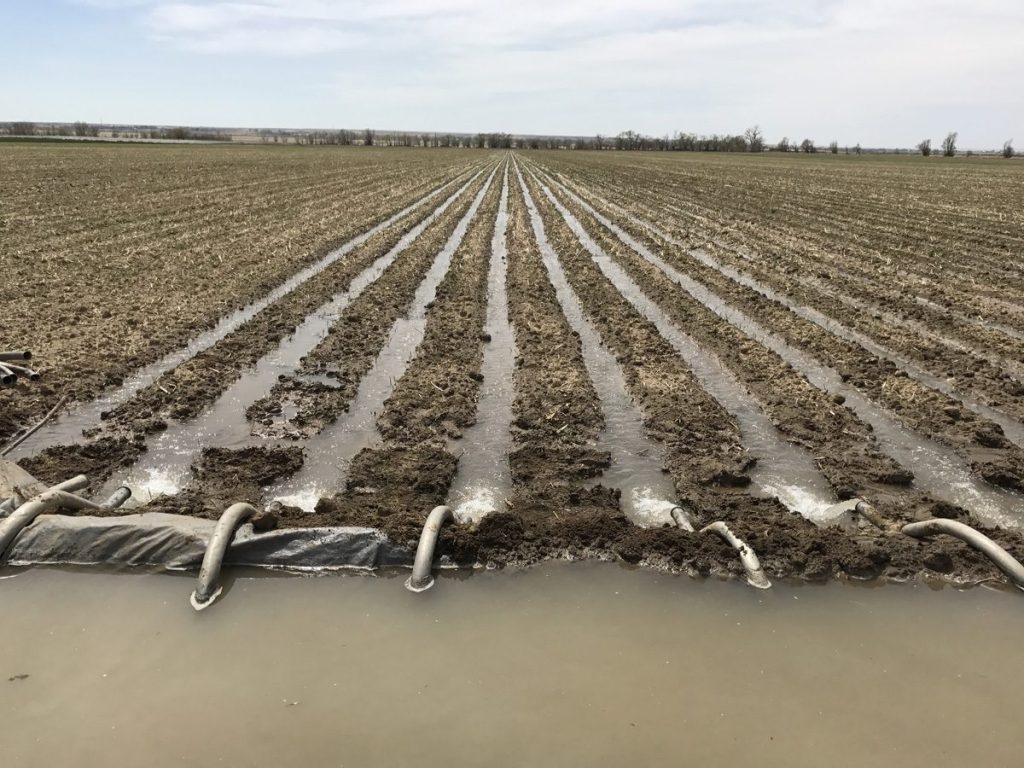
Flood irrigation in a Colorado oat and triticale field.
Source: Colorado Public Radio
Sprinkler systems are also used and can provide even water distribution over the field using spray droplets. There is less risk of oversaturation when using sprinkler irrigation. Center pivot, traveling guns, and low-pressure traveling irrigators are examples of sprinkler systems that can be used for growing forage crops, including triticale (Milhollin et al. 2023).
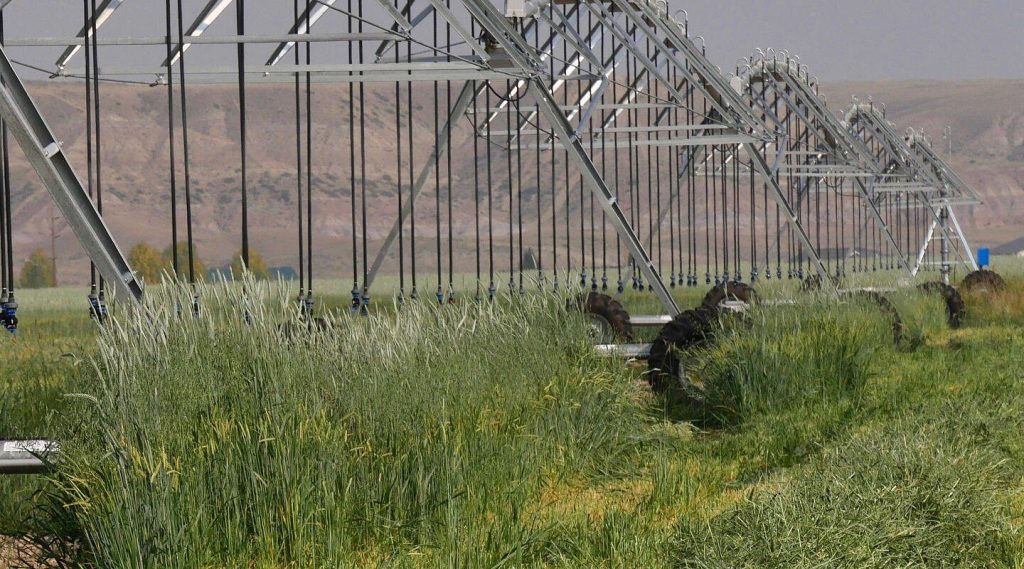
Center pivot irrigation system
Source: Valley Irrigation
Irrigation Scheduling and Management Strategies
Optimizing irrigation schedules according to the tritcale crop’s water needs helps promote forage and grain quality and yield while reducing irrigation costs. Farmers can monitor soil moisture levels in the root zone using any of these methods:
- soil feel and appearance
- soil moisture probes
- gravimetric soil sampling
- tensiometers
- resistance blocks
After the crop emerges, the first irrigation event should occur when 40 to 50 percent of the stored soil moisture has been used. The University of California suggests that flood or furrow irrigation should bring the upper 3 feet of soil to field capacity, with 4 to 8 inches of water applied per irrigation event. For sprinkler irrigation, they recommend applying 2 to 4 inches of water per irrigation event (University of California et al. 2006). The recommended number of seasonal irrigation events for several California triticale growing regions is shown in the chart below.
Some triticale varieties may be more drought-tolerant than others, requiring fewer irrigation events per season. Environmental conditions, soil type, geography and crop growth stage will also affect irrigation scheduling.

Number of irrigations recommended for small grain crops in California regions.
Source: University of California
Irrigation Cutoff Determination
- increase the risk of lodging and disease pressure
- stimulate weed growth
- delay groundwork and harvest
- add unnecessary irrigation costs
Irrigation cutoff is subjective and varies from season to season, depending on the root zone depth and the soil’s water-holding capacity. The goal is to carry the crop through the end of dry matter accumulation (late dough stage) with sufficient moisture.
Irrigation cutoff in fields with sandier soils and shallower roots may be 7 to 10 days before the late stages of dough development. For finer soils and crops with deeper root systems, irrigation may be discontinued sooner (two to three weeks before the late stages of dough development).
TerraFlow® Irrigation Enhancing Technology
Optimized irrigation schedules can help triticale growers maximize their crop’s potential, whether they’re producing forage or grain. But many farmers may not realize that the physical properties of their irrigation water can affect its efficiency in the soil and in plants. Surface tension and molecular organization are key factors in how well water hydrates.
TerraFlow by UpTerra enhances the hydrating properties of water by reducing surface tension and reorganizing water’s structure, allowing it to be more easily absorbed by plants. This plug-and-play device is compatible with most irrigation systems, improving moisture distribution in the soil.
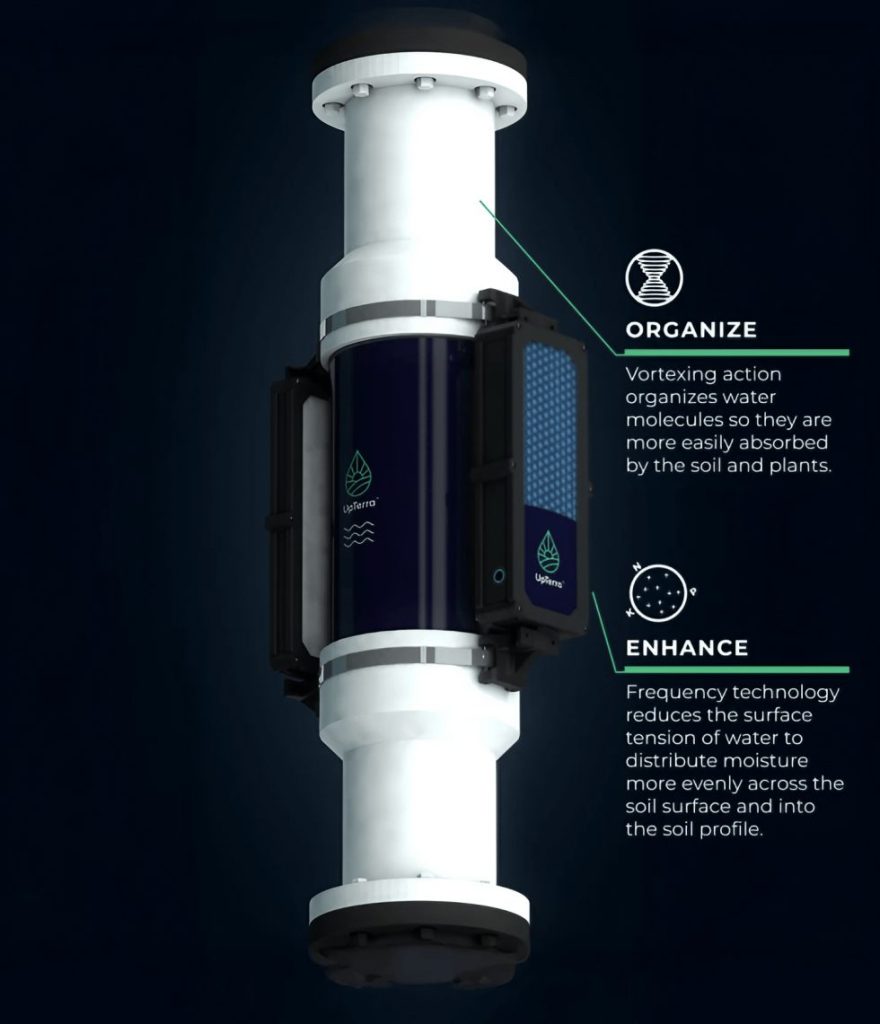
UpTerra’s TerraFlow device installs easily into most irrigation systems to enhance the hydrating properties of water.
With TerraFlow, water spreads more evenly across and into the soil profile, contributing to improved water availability and retention. Growers can expect better nutrient uptake, more microbial activity in the root zone, less plant stress and healthier soils. Over time, these benefits compound, helping growers produce more with fewer inputs.

TerraFlow technology for triticale irrigation systems improves moisture distribution in the soil.
Triticale farmers have seen dramatic results using TerraFlow:*
- Up to 66% silage yield increase
- 1.3 more pounds of crude protein supplied per day
- 1.1 pounds/cow/day forage reduction
- 2.7% increase in forage total dietary fiber (TDF)
Irrigation That Works For Triticale Producers
Every triticale grower has different needs and therefore will require a customized irrigation strategy. Whether it’s a forage, grain or cover crop, the best plan should meet the crop’s moisture needs while conserving water resources.
TerraFlow makes this easier for farmers by enhancing water distribution and soil moisture availability. With simple installation and a low startup cost, TerraFlow helps triticale growers maximize every drop. Lower input costs, stronger root and soil health and higher yield potential are all possible with TerraFlow.
Wondering if TerraFlow could be a good fit for your farm? Contact an UpTerra representative to get the conversation started.
*Based on farm trials conducted with UpTerra growers. Results compare crops with UpTerra-treated water and standard irrigation (untreated) controls.
References
Cronin, Dana. 2017. Crowley County: A ‘Poster Child’ for Less Water? Colorado Public Radio.
Crop Quest. 2024. Triticale an Alternative Crop to Wheat and Rye. Crop Quest.
Grains Research and Development Corporation. 2018. Triticale: Plant Growth and Physiology.
Marsalis, Mark A. 2018. Small Grain Forages for New Mexico. New Mexico State University.
Milhollin, Ryan, Drew Kientzy, Stacey Hamilton and Ryan Lock. 2023. Forage Crop Irrigation Systems and Economics. University of Missouri.
Allan Fulton, Khaled Bali, Zak Mousli and Lee Jackson. 2006. Small Grain Production Manual Part 5: Irrigation and Water Relations. University of California.
Valley Irrigation and Andy Oerman. 2019. Switching from Flood to Pivot Irrigation Leads to Tripled Hay Production. Valley Blog.
Yang Dan, Shuyun Zhang, Xinhui Tian and Wenhua Du. 2023. Morphological and Physiological Traits of Triticale as Affected by Drought Stress. Chilean Journal of Agricultural Research 83:2 (April): 203-216.

